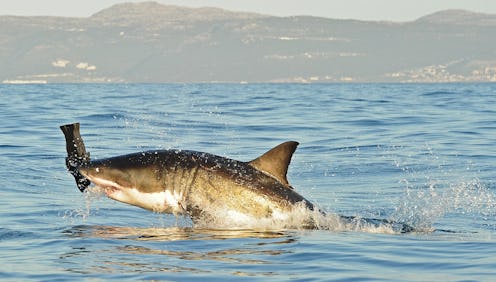Entertainment
The Cojimar Shark Is The Ocean's Very Own Big Foot
If you haven't heard of the Cojimar shark, also known as the Cojimar Specimen, you're about to get a pretty familiar with it now that Discovery Channel's Shark Week is tackling "El Monstruo" on Sharks of Cuba. Just in case all of those words sound like nonsense to you, here is a quick primer: Cojimar is a small fishing village in Cuba that (aside from being the inspiration for The Old Man and the Sea) was also the birth place of a local legend that has spread into a worldwide phenomenon. Back in the 1940s a group of fisherman caught a great white shark that allegedly reached over 21 feet long and was estimated to weigh 7,000 pounds. Yeah, that's a giant freaking shark. This bad boy was so monstrously big (not to mention nightmare inducing, for anyone who has ever seen Jaws) that they named it "El Monstruo" (the monster). Sound pretty cut and dry? Well, almost.
You see, this shark was captured and killed long before standardized measurements, and all we have to go on is one black and white photo. Between the lack of scientific evidence and the widely held belief that fisherman tend to exaggerate the size of their catches (I can attest to that for sure, I once swore a guppie was a salmon) most research suggest that the Cojimar shark was a great white, but not quite the epic beast of legend.
In fact its myth is getting so great that I think it's ready to join the ranks of these other much-exaggerated myths.
1. Big Foot
The original gangster of over-hyped beasts of the wild, this man/ape/monster has evolved into a full blown legend over the last few decades. Though I think we can rest assured that it's not actually lurking outside of any campgrounds.
2. The Loch Ness Monster
Did you know that "Nessie" is actually thought to be a remnant of the plesiosaurs era? That's right, if she exists at all she is an actual dinosaur. Though evidence as to her existence is questionable at best, I like to believe this Scottish beast survived extinction.
3. El Chupacabra
This literally translates to "goat-sucker" for good reason. This myth of the Americas is known for it's habit of attacking and drinking the blood of livestock, especially goats. It's also effective for scaring children into getting to bed on time. Creepy, and most definitely a myth.
4. Vampires
These blood sucking creatures can be traced all the way back to the 1700s, though they are experiencing a major uptick in popularity these days thanks to numerous books and moves that have made them a cultural phenomenon. They started out as creepy blood suckers and have steadily evolved to have some serious sex appeal. Totally myth, (un)fortunately for us, but alive and well on the CW.
5. Werewolves
Much like vampires, these fictional beasts have evolved from terrifying monster to Teen Dream. Man by day, wolf by night, and completely made up. No scientific measurement needed.
6. Moby Dick
While there haven't been any great works of literature written for El Monstruo, it still has the most in common with the fictional white whale. They are both large and in charge, with an indefinite size and a gnarly reputation.
And, who knows? Maybe now that American relations with Cuba are opening up, we'll get to see more of the Cojimar shark for ourselves.
Images: Giphy(5)
